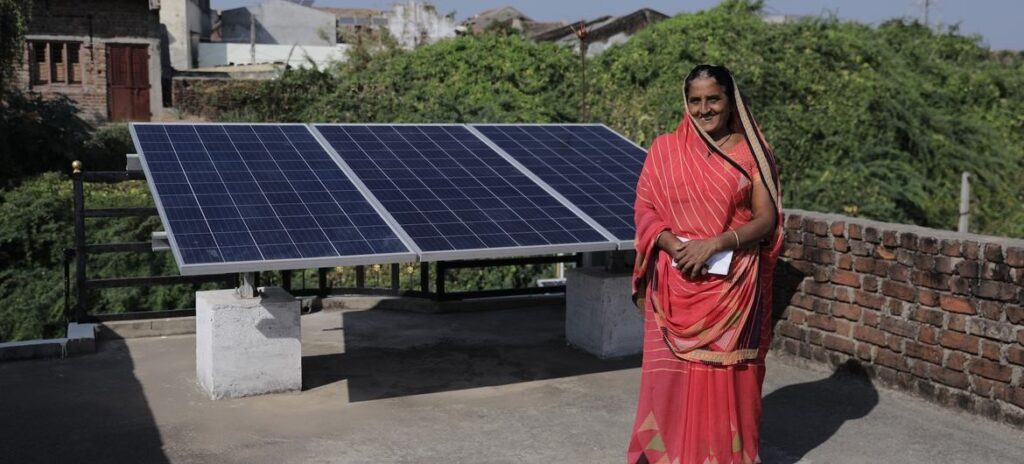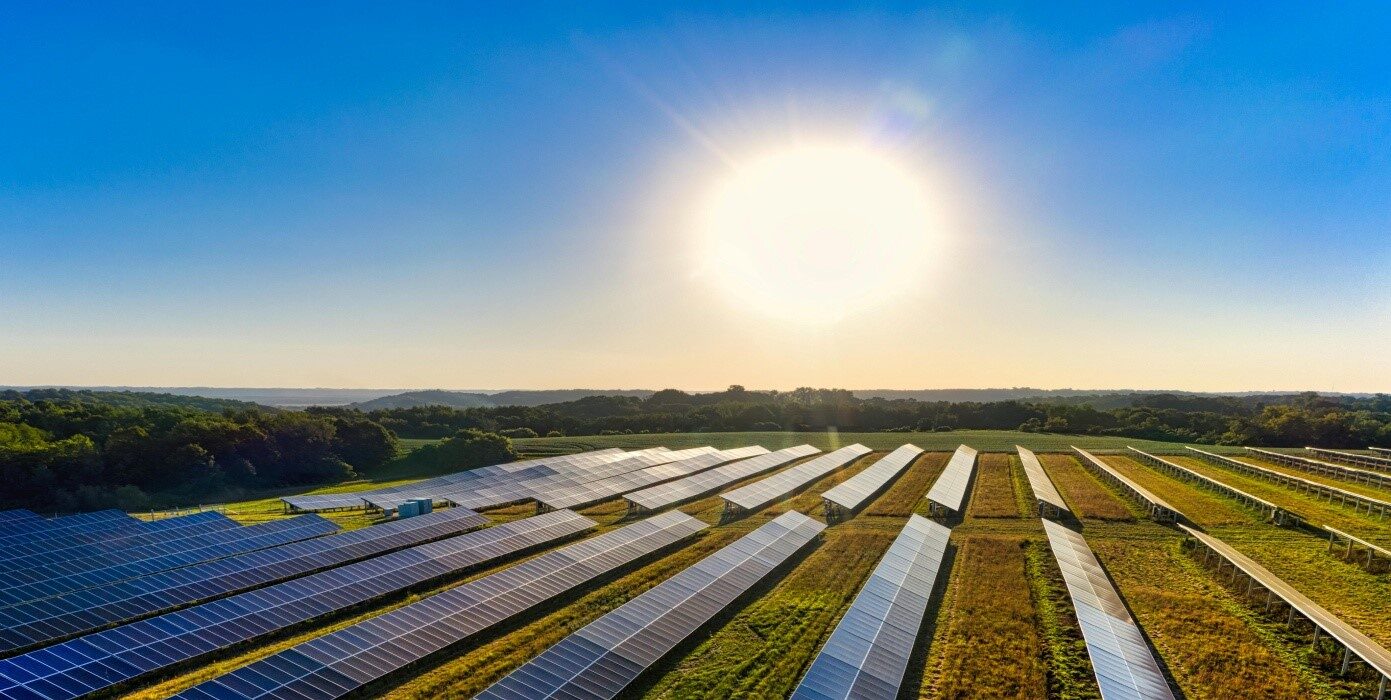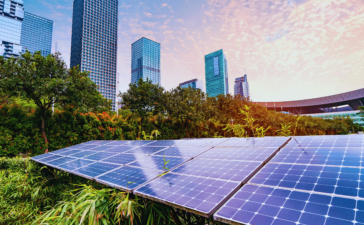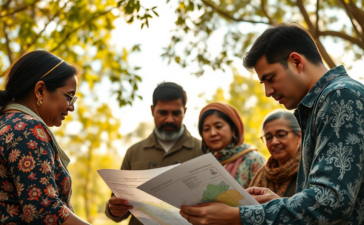“A world powered by clean energy isn’t just a vision—it’s a necessity”.
As India accelerates its renewable energy transition, it is not only lighting up villages but also illuminating the path toward achieving global Sustainable Development Goals (SDGs), proving that sustainable solutions can drive both local prosperity and global progress. This article positions India’s efforts to promote renewable energy adoption in rural areas within the context of the United Nations Sustainable Development Goals (SDGs), highlighting the interconnectedness of local action and global impact.
Introduction: India’s Solar Vision and the Global Goals
As the world grapples with climate change and sustainable development challenges, renewable energy emerges as a pivotal solution. India, with its vast population and growing energy demands, has embraced renewable energy to foster economic growth, ensure environmental sustainability, and enhance energy security. This commitment positions India as a key player in achieving the global SDGs. The nation aims for 50% of its total power capacity to come from non-fossil fuel sources by 2030, demonstrating its commitment to a cleaner energy future (Clean Grid Alliance, n.d.). These efforts closely align with the United Nations Sustainable Development Goals (SDGs), a set of global targets aimed at achieving a more sustainable and equitable world by 2030 (Sustainable Development UN, n.d.). Solar village initiatives play a crucial role in advancing several SDGs, showcasing the interconnectedness of local action and global impact.
India’s Renewable Energy Initiatives
Domestic Programs
India has launched several ambitious programs to promote renewable energy, aligning with its commitment to achieving 50% of its installed capacity from non-fossil fuel sources by 2030 (NITI Aayog, 2018). Some key initiatives include:
- National Solar Mission (NSM): Launched in 2010, the NSM aims to establish India as a global leader in solar energy by achieving 100 GW of solar power capacity. As of 2023, India has already surpassed 70 GW, making it the fifth-largest solar power producer globally (International Renewable Energy Agency [IRENA], 2023). The initiative promotes grid-connected and decentralized solar power projects, particularly in rural areas (Government of India, 2020).
- State-Level Policies: Several states, including Rajasthan, Gujarat, and Karnataka, have implemented tailored policies to encourage renewable energy adoption. For instance, Gujarat’s Surya Urja Rooftop Scheme provides subsidies up to 40% for residential solar installations (PIB, 2023). Similarly, Rajasthan’s Solar Energy Policy 2019 focuses on large-scale solar parks and decentralized solutions for rural electrification (CEEW, 2023).


India’s leadership in renewable energy extends beyond domestic policies, shaping global energy transitions while aligning with Sustainable Development Goals (SDGs) 7 (Affordable & Clean Energy), 13 (Climate Action), and 17 (Global Partnerships) (United Nations, 2020).
India’s Leadership in the Global Solar Arena
- International Solar Alliance (ISA)
India’s efforts to scale up solar energy are recognized globally, positioning the nation as a “solar superpower” and a key player in the global energy transition (India.un.org, n.d.). India co-founded the International Solar Alliance (ISA) in 2015 in collaboration with France, bringing together over 120 countries to accelerate solar energy deployment worldwide (ORF, 2024). The ISA fosters:
- Collaborative Research & Knowledge Sharing: ISA facilitates global research programs to improve solar efficiency and affordability, particularly in developing nations (REN21, 2023).
- Financial Mobilization: ISA has attracted over $1 billion in commitments for solar projects in Africa and Asia, with India contributing through low-interest loans and technology transfers (World Bank, 2023).
- Global Impact: Through ISA, India is driving initiatives such as One Sun, One World, One Grid (OSOWOG), aiming to create a transnational solar grid connecting Asia, Africa, and Europe (United Nations, 2020).
- India’s Leadership in Solar Energy within BRICS and its Global Impact
India plays a pivotal role within BRICS and exerts significant global influence by advancing renewable energy and solar village initiatives. The country’s strong emphasis on solar energy substantially contributes to its sustainable development goals and strengthens BRICS’ collaborative efforts to address global energy challenges. India’s leadership in solar energy positions it as a key player within BRICS and on the world stage, demonstrated by its capacity to host the G20 Summit.
India spearheads solar power deployment among BRICS countries, driven by initiatives like the National Solar Mission and the International Solar Alliance (ISA). By 2022, India had installed over 40 GW of solar capacity and aims to reach 100 GW by 2030. While China leads globally in solar installations, India’s solar village projects, integrating solar microgrids and solar home systems, offer a valuable model for decentralized energy solutions, particularly in rural regions. India’s leadership within the ISA significantly influences BRICS countries, driving cooperation on solar energy technology, policy frameworks, and financing mechanisms.
BRICS countries actively collaborate through platforms such as the BRICS Energy Research Cooperation Platform to increase renewable energy adoption. India plays an active role by promoting solar power innovations and disseminating best practices from its successful solar village projects. These projects have improved education, healthcare, and economic opportunities in rural India, and India actively seeks to share these models with other BRICS countries, especially in Africa and South America, through various knowledge-sharing forums.
India actively co-finances renewable energy projects within the BRICS framework. Through multilateral initiatives and collaboration with institutions such as the BRICS New Development Bank (NDB), India spearheads investments in solar energy infrastructure in developing countries. India’s commitment to scaling solar energy in rural communities aligns with the NDB’s objective of supporting green energy projects in BRICS member states.
India’s solar village model has garnered international recognition as a viable and scalable solution to rural energy access, particularly in off-grid communities. These models prioritize community ownership, local entrepreneurship, and sustainability, substantially contributing to SDG 11 (Sustainable Cities and Communities) and SDG 1 (No Poverty).
India’s success in deploying decentralized solar systems in its rural areas offers a scalable and adaptable model for other BRICS nations, including rural areas in China, South Africa, and Brazil, where solar energy effectively alleviates energy poverty while simultaneously promoting sustainable economic growth.
Solar Villages and Their Contribution to the SDGs
India’s focus on renewable energy and, specifically, solar village development, directly contributes to achieving several SDGs:

Source: Author’s Creation
- SDG 7: Affordable and Clean Energy: Solar village projects provide access to affordable, reliable, and modern energy services in rural areas, which is a core target of SDG 7. By deploying decentralized renewable energy (DRE) systems like solar microgrids and solar home systems, India is addressing energy poverty and promoting clean energy solutions (IRENA, 2023).
- SDG 13: Climate Action: Transitioning to solar energy significantly reduces greenhouse gas emissions, mitigating the impacts of climate change. India’s commitment to expanding solar power contributes to global efforts to combat climate change and achieve the goals of the Paris Agreement (pib.gov.in, 2023).
- SDG 5: Gender Equality: Initiatives like the E-Mbak Mina program in Indonesia empower women through renewable energy management, demonstrating the link between solar energy and gender equality (SDGs Partnership, n.d.). By providing women with new skills and economic opportunities, solar energy projects contribute to gender empowerment.
- SDG 11: Sustainable Cities and Communities: Solar energy projects enhance the sustainability and resilience of rural communities. Access to reliable energy improves living standards, supports local businesses, and enables access to essential services like education and healthcare, contributing to the development of sustainable communities (smartcities.gov.in, 2023).
- SDG 1: No Poverty: Access to energy is a crucial enabler for poverty reduction. Solar energy can power income-generating activities, improve agricultural productivity, and support small businesses, thereby contributing to poverty alleviation in rural areas (CEEW, n.d.).
Challenges and Opportunities
While India has made significant strides in renewable energy deployment, several challenges hinder the widespread adoption of solar solutions and their contribution to the Sustainable Development Goals (SDGs). Addressing these obstacles requires financial innovation, effective policy implementation, and long-term capacity building.
Financial and Technological Gaps
- Despite government subsidies and private sector investments, financial barriers remain a significant roadblock in scaling solar adoption in rural India. A major issue is the high upfront cost of solar infrastructure, particularly in off-grid villages where extending the power grid is economically unviable (RePEc, 2016).
For Instance, the PM-KUSUM scheme, launched in 2019, provides financial assistance to farmers to install solar-powered irrigation pumps, reducing dependency on diesel and grid electricity. However, adoption rates remain low due to limited access to credit and a lack of financial literacy among small-scale farmers (PIB, 2023). Expanding microfinance models and introducing low-interest solar loans could bridge this gap.
- Technological advancements also pose a challenge, as many rural households lack awareness and expertise in maintaining solar systems. Innovations such as hybrid solar grids and energy storage solutions can increase reliability and expand access in remote areas (CEEW, 2023).
Policy Implementation Gaps
- India has developed strong renewable energy policies, including the National Solar Mission and Renewable Energy Service Companies (RESCO) model, yet inconsistent state-level execution and bureaucratic delays often hinder large-scale adoption (UNDP, 2024). Some states impose high grid-integration fees, discouraging small-scale solar projects and slowing expansion in rural areas.
For Example: The Delhi Solar Policy 2016 successfully incentivized rooftop solar installations, resulting in over 250 MW of installed capacity in urban centers. However, rural states such as Bihar and Jharkhand still face delays due to land acquisition issues and lack of financial incentives (IRENA, 2023). Standardizing state-level policies and reducing bureaucratic red tape will accelerate solar adoption nationwide.
Capacity Building and Workforce Development
- Investing in human capital and technical expertise is crucial for ensuring the long-term sustainability of solar projects. Many solar installations in rural areas fail due to a lack of trained personnel to maintain and repair systems (CEEW, n.d.).
For Instance, The Barefoot College Solar Program has trained over 3,500 rural women from 93 countries as solar engineers, enabling them to install and maintain solar home lighting systems in off-grid communities (ISA, 2024). Scaling similar training programs at the Panchayat and Anganwadi levels can enhance local ownership and ensure project sustainability. (Week 2)
- Efforts must focus on integrating skill development into India’s rural workforce, empowering communities not just as consumers but as active participants in solar energy adoption.
Opportunities for Scaling Solar Adoption
Despite these challenges, several opportunities exist to enhance India’s solar energy expansion and maximize its impact on global sustainability goals:
- Expanding Public-Private Partnerships (PPPs): Collaboration between state agencies, private investors, and NGOs can create innovative business models for solar microgrids (CEEW, 2023).
- Strengthening Rural Financing Mechanisms: Introducing solar-specific microfinance options, similar to the Bangladesh Solar Home Systems model, can increase affordability for low-income households (World Bank, 2023).
- Leveraging International Cooperation: The International Solar Alliance (ISA) can facilitate technology transfers, capacity-building programs, and financial aid to accelerate India’s solar village projects (UNDP, 2024).
- Policy Reforms: As per NITI Aayog, (2021) reducing interstate regulatory barriers, offering tax incentives, and streamlining land acquisition for solar farms can accelerate deployment.
- With targeted interventions, strategic investment, and stronger policy execution, India can overcome these barriers and establish itself as a global leader in decentralized renewable energy solutions.
Addressing these challenges presents significant opportunities for India to further enhance its contribution to the SDGs and lead the global transition to a sustainable energy future.
Conclusion: A Global Responsibility
India’s solar village initiatives exemplify the crucial link between local energy solutions and global sustainable development. By prioritizing community engagement, promoting innovative technologies, and implementing supportive policies, India can continue to make significant strides in achieving the SDGs and inspiring other nations to follow suit. The nation’s commitment to solar energy not only empowers its own rural communities but also contributes to a more sustainable and equitable world for all.
“A brighter world is powered not just by the sun, but by the collective resolve to harness it for the good of all.”
References
- International Solar Alliance. (n.d.). Retrieved from https://isolaralliance.org
- United Nations. (n.d.). India and the Sustainable Development Goals. Retrieved from https://sustainabledevelopment.un.org/memberstates/india
- Observer Research Foundation. (2023). India and the Global Commons: A Case Study of the International Solar Alliance. Retrieved from https://www.orfonline.org/research/india-and-the-global-commons-a-case-study-of-the-international-solar-alliance
- Council on Energy, Environment and Water. (n.d.). How can global good practices mainstream decentralised renewable energy and achieve sustainable development goals. Retrieved from https://www.ceew.in/sites/default/files/how-can-global-good-practices-mainstream-decentralised-renewable-energy-and-achieve-sustainable-development-goals.pdf
- NITI Aayog. (2018). SDG India Index Baseline Report. Retrieved from https://www.niti.gov.in/sites/default/files/2020-07/SDX_Index_India_Baseline_Report_21-12-2018.pdf
- United Nations in India. (n.d.). India: Solar Superpower. Retrieved from https://india.un.org/en/289652-india-solar-superpower
- ResearchGate. (n.d.). The role of renewable energy in achieving sustainable development goals. Retrieved from https://www.researchgate.net/publication/385696779_The_role_of_renewable_energy_in_achieving_sustainable_development_goals
- REN21. (2023). Renewables 2023 Global Status Report. Retrieved from https://www.ren21.net/wp-content/uploads/2019/05/REN21-RESR-2023_LowRes.pdf
- Koshish India. (n.d.). Sustainable Development Goals. Retrieved from https://www.koshishindia.in/blogs/sustainable-development-goals
- Press Information Bureau. (2025). India’s Renewable Energy Achievements. Retrieved from https://pib.gov.in/PressReleasePage.aspx?PRID=2032857
- ScienceDirect. (n.d.). The role of renewable energy in achieving sustainable development goals. Retrieved from [https://www.sciencedirect.com/science/article/pii/S
Discover more from Future of Society
Subscribe to get the latest posts sent to your email.





